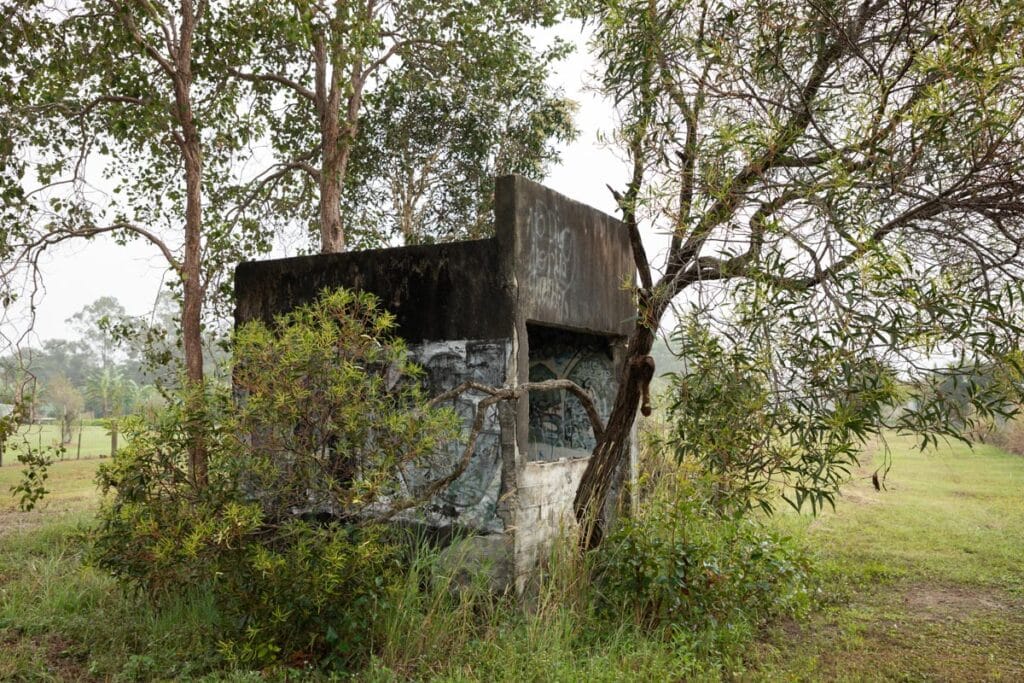
The Bundaberg SFTS Air Gunnery and Bombing Range Shelter No.1 is located south of Bundaberg Airport at Parklands Estate and is a symbol of the region's involvement in World War II.
Following the outbreak of the war British, Australian and Canadian governments formed an agreement to establish the Empire Air Training Scheme in an effort to train the thousands of pilots and air crew needed to fight the war.
Bundaberg Airport, at the time a civilian facility, was selected as one of 36 bases across Australia to support the training scheme.
The No. 12 Elementary Flying Training School RAAF operated on the site from 16 October 1941 until it was relocated to Lowood Aerodrome in January 1942.
From late 1941, the No. 8 Service Flying Training School RAAF (No.8 SFTS) also operated from the Bundaberg Airport base.
Basic bomb aimer training and air gunnery skills were part of the training given to pilots by the No.8 SFTS, using twin engine 1930s Avro Anson fabric covered aircraft.
To facilitate this training, a practice bombing and air gunnery range was located south of the primary Bundaberg aerodrome.
According to the Australian War Memorial, there were multiple stages of training given to pilots under the Empire Air Training Scheme.
Elementary Flying Training Schools provided students with initial pilot training, with successful graduates going on to the Service Flying Training Schools for instruction in operational flying.
Air gunnery and bombing raid shelter
The Bundaberg SFTS Air Gunnery and Bombing Range Shelter No.1, located at Parklands Estate, is a 2.6 metre x 2.6 metre square concrete block and concrete rendered bunker with 230 mm thick external walls.
It is 2.7 metres high, with a 1.5 metre high parapet to its primary elevation, oriented east-south-east.
The entrance to the shelter, with evidence of the door remaining, leads to a one metre high observation window, which appears to have had steel screening.
Much of the 30 mm thick concrete render that was applied to the entire structure has peeled away, with some green and yellow painted markings remaining that may indicate original details.
While the use of the shelters is unclear, it is thought that they were used as observation points by ground crews servicing gunnery targets on the ground.
Targets for bombing and training purposes usually consisted of wooden replicas of landing barges and similar structures.
In January 1943, RAAF No. 71 Squadron was formed at RAAF Station Lowood, Queensland, from aircraft and aircrew drawn from No. 8 Service Flying Training School.
RAAF No. 71 Squadron figured strongly in the operation of coastal surveillance aircraft and convoy protection duties.
According to the Australian War Memorial, by the time the Empire Air Training Scheme ended in October 1944 (formally suspended on 31 March 1945), over 37,000 Australian airmen had been trained.
In 2021, the RAAF Bundaberg Station marked its 80th anniversary, the same year the Royal Australian Air Force marked 100 years of service to Australia.
Surviving World War II features at the airport, including the air gunnery and bombing raid shelter, are listed on Bundaberg Regional Council’s Local Heritage Places Place Card.








Where is the actual address please? Is it on Private Property? I can ride my bike there?
Thank you in advance.
Wendy
Is this one of the ones that was or is on what used to be my parents property now mostly Kentucky Bluegrass?